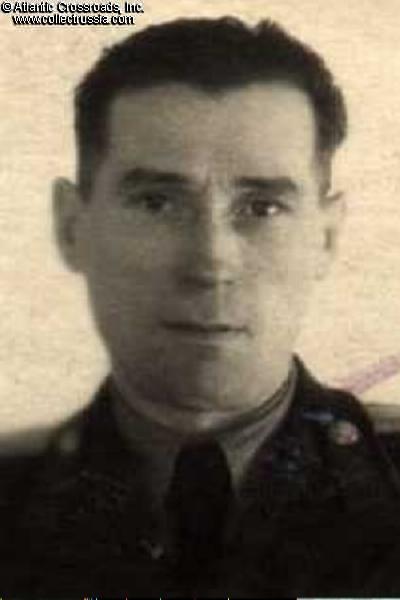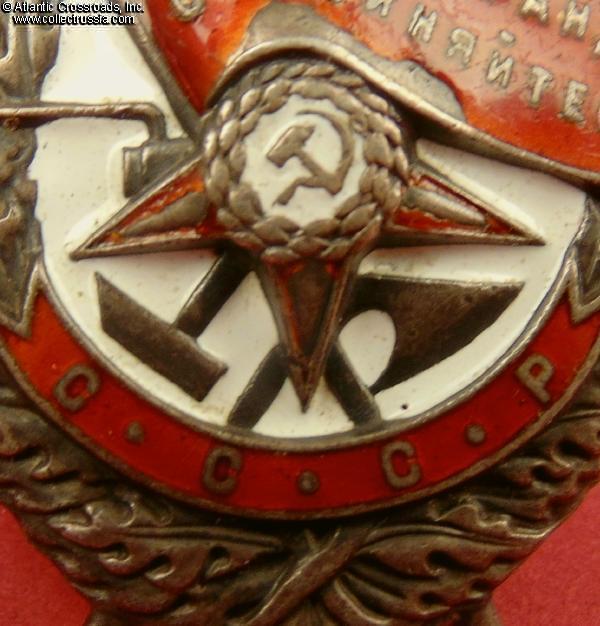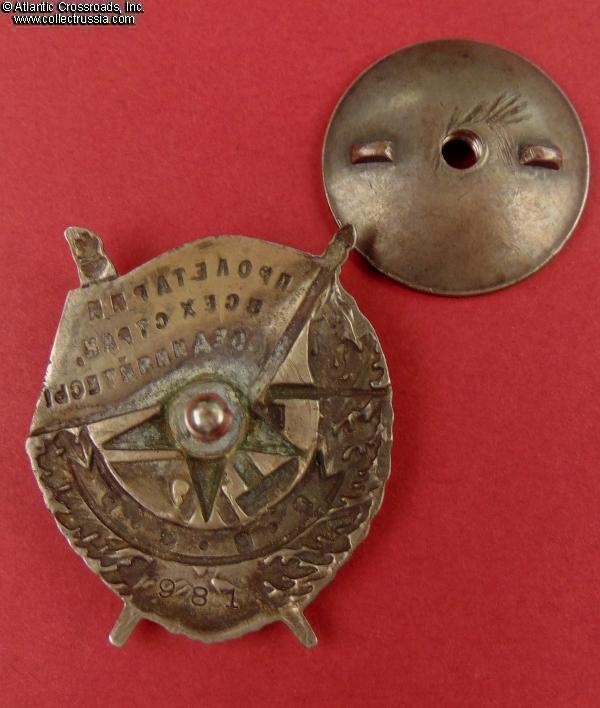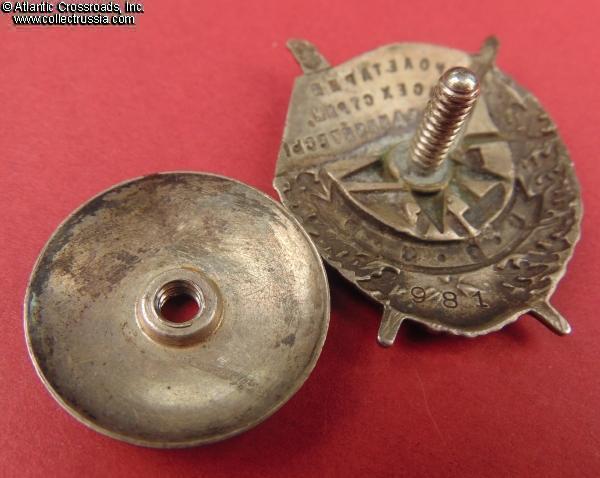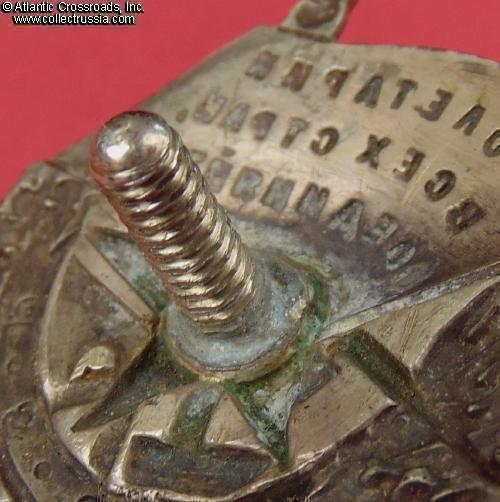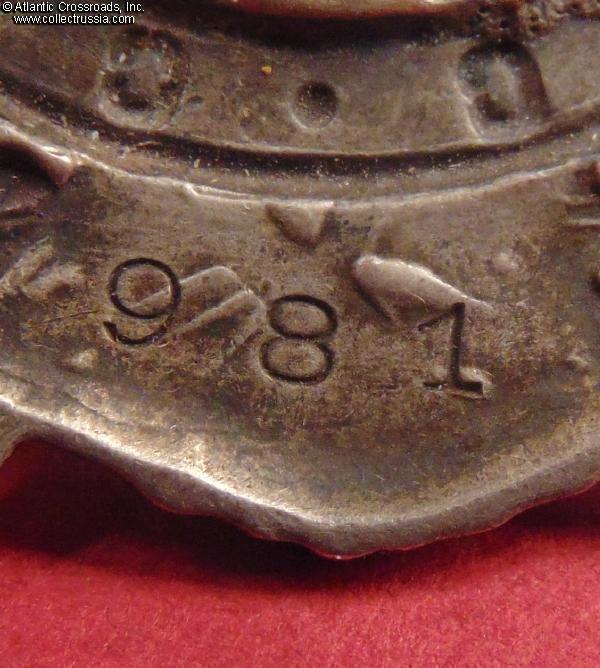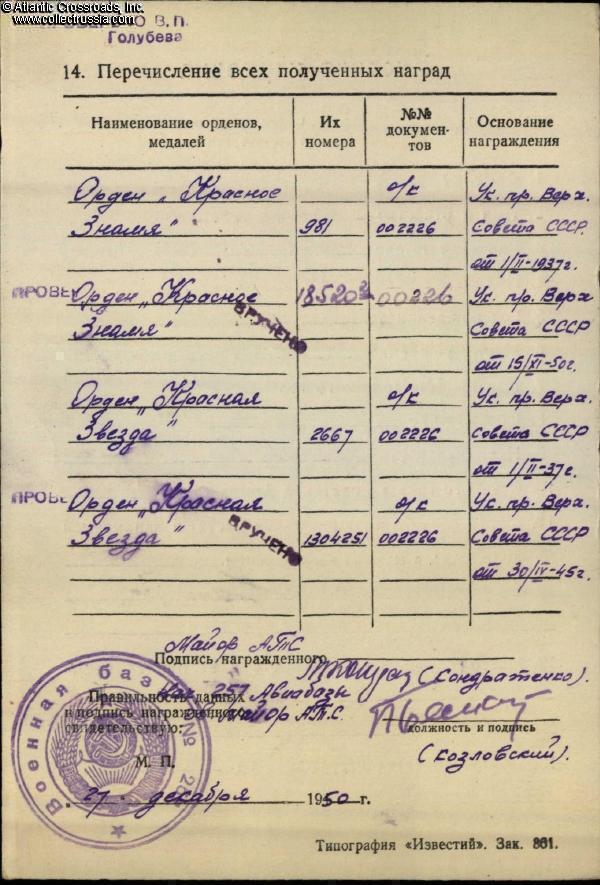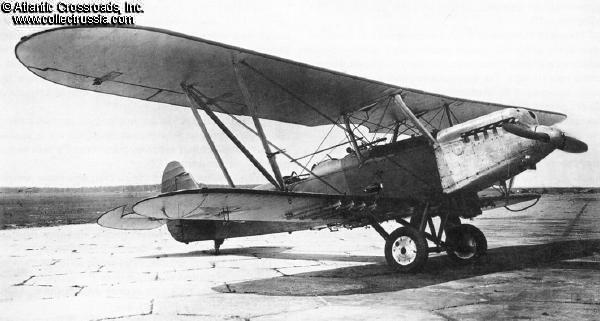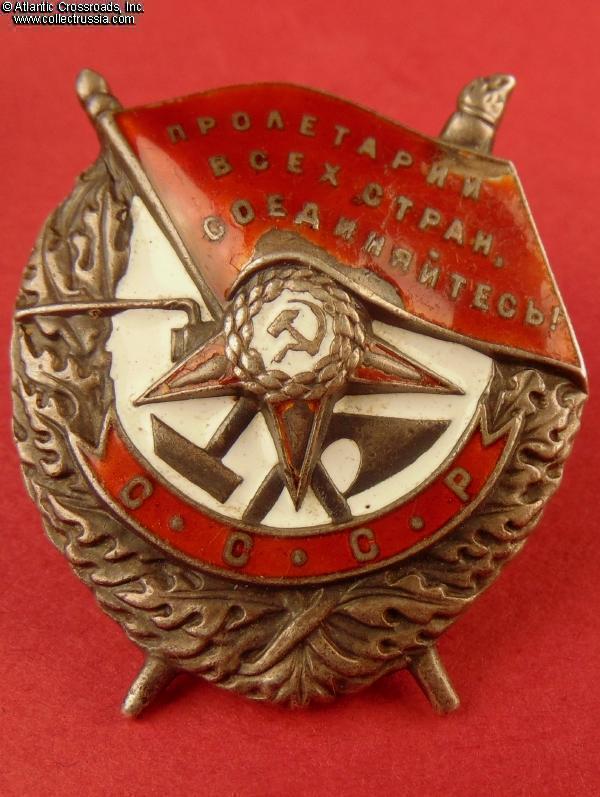
Order of the Red Banner, Type 1, Variation 2, Sub-variation 2 (according to the Durov & Strekalov classification), #981, awarded on 1 February 1937 to Mikhail Kondratenko (Михаил Николаевич Кондратенко), aviation technician, for his participation in the top-secret Soviet intervention in the Spanish Civil War as an adviser with the 15th Ground Attack Group of the Spanish Republican Air Force.
Silver gilt, enamels. Measures 39.8 mm in height (from the top of the flag to the bottom of the wreath); 35.8 mm in width; weighs 21.8 g not including the screw plate. The screw post is approx. 4.4 mm in diameter. This so-called "Mirror Reverse" version of the order (Type 1 Var. 2 according to the McDaniel classification) features very sharp counter-relief on the reverse as opposed to the typically smoother lines of the later Type 1 specimens. Note the three-digit serial number, exceptionally low even for the "Mirror Reverse" Red Banner. Based on The Order of the Red Banner <
Silver gilt, enamels. Measures 39.8 mm in height (from the top of the flag to the bottom of the wreath); 35.8 mm in width; weighs 21.8 g not including the screw plate. The screw post is approx. 4.4 mm in diameter. This so-called "Mirror Reverse" version of the order (Type 1 Var. 2 according to the McDaniel classification) features very sharp counter-relief on the reverse as opposed to the typically smoother lines of the later Type 1 specimens. Note the three-digit serial number, exceptionally low even for the "Mirror Reverse" Red Banner. Based on The Order of the Red Banner by Durov and Strekalov, this piece is from the small series manufactured by the Leningrad Mint in 1933.
The order is in fine condition, which would be respectable even for a regular WW2 "screw back", let alone a "Mirror Reverse" of pre-WW2 vintage. The red enamel on the banner has chips in the upper right corner and at the lower edge above the star; there are also additional small areas of surface flaking along the edges and small contact marks throughout. The enamel on the banner however is free of the usual repairs, retains a nice luster, and overall, better preserved than on most other surviving screw back issues.
The red enamel is mostly missing on the arms of the star in the center, with only traces of it remaining. The red plaque at the bottom, on the other hand, is practically intact having only some tiny contact marks - no chips, flaking, or other significant wear of any kind. The enamel fully retains beautiful luster everywhere. The white enamel is likewise well-preserved having only some microscopic contact marks and flakes, no wear visible to the naked eye.
The details of the wreath, torch and flagpole are very crisp, nearly pristine. The reverse is literally untouched and shows beautiful even patina. The screw post is nearly 14 mm in length, has not been shortened. It comes with a special 28-mm screw plate which, in theory, is correct for the "Mirror Reverse" Red Banners in a higher serial number range. The screw plate however is of the period, shows matching patina, and fits the screw perfectly; therefore, there is every reason to believe that it was used by the original recipient instead of the "correct" 32-mm silver screw plate.
Mikhail Kondratenko was born in 1907 in a village of the Bobruisk District, Mogilev province of Belorussia. In November 1929, he joined the Red Army, most likely by enrolling in a school of junior aviation specialists. Upon graduation, he was given the rank of Military Technician, 2nd Rank (an equivalent of Lieutenant) and reportedly, appointed as aviation technician to the 9th Ground Attack Air Squadron.
In the fall of 1936, Kondratenko was selected to join an elite group of Soviet "military advisors" sent to Spain to assist the Republican government reeling under the onslaught of Franko's rebels. The Soviet intervention began in 1936, almost from the start of the conflict, and it is noteworthy that Kondratenko was among the first Soviets combatants to go to Spain. Although the Soviet Union openly provided massive amounts of armaments to the radical left Spanish government, the presence of Soviet military men and their participation in combat remained a carefully guarded secret. Based on various Internet sources, only 1811 Soviet "military specialists" took direct part in the war, including 772 aviators. They were carefully selected from trusted volunteers, given fake identities, and sent to join various units of the Spanish Republican Army fighting General Franko's Nationalist rebels. Unlike the International Brigades volunteers from other nations, all the Soviet combatants were active-duty military personnel and remained so during their foreign tour.
Kondratenko reportedly was assigned to the 15th Ground Attack Brigade of the Spanish Republican Air Force which was equipped with the Soviet-made R-5s. This all-wood biplane designed primarily for reconnaissance was already long obsolete by the time it appeared in Spain, but it was nevertheless put to good use by the hard-pressed republican troops. The R-5s made some successful bombing and strafing attacks on Franko's airfields, but soon the inferiority of the airplane in speed and armament to the more modern aircraft models led to mounting losses. The 15th Ground Attack Brigade was disbanded in May 1937, which is probably the reason Kondratenko returned home during that year.
While he was apparently still in Spain or immediately upon his return, Kondratenko was awarded with not one but two decorations - a highly uncommon case! Moreover, both awards, the Order of the Red Banner #981 and the Order of the Red Star #2667, were bestowed by the same decree of the Supreme Soviet of the USSR on 1 February 1937. Due to the highly secretive nature of his assignment, no award commendations or other information concerning Kondratenko's achievements could be found in the Russian archives at this time. Judging by the date of the two awards however, it is absolutely certain that both were indeed for the Spanish Civil War. It is also confirmed by the information about Kondratenko that was found online.
Based on one of the Russian websites, after his return from Spain Kondratenko was assigned to the 20th Fighter Aviation Regiment of the Kiev Military District and later, served with the aviation units of the Orel Military District. According to the award card, his only decorations of the Patriotic War period were the Order of the Red Star and Order of the Red Banner awarded in April 1945 and November 1950, respectively, both apparently for the length of service in the military. As of 1950, he served as the engineer of the 257th Military Aircraft Processing and Storage Facility. Kondratenko retired from active service in June 1954, having the rank of major. Further details of his service may be revealed in the future with the publication of historical research on the Spanish Civil War and possible further opening of the Russian archives.
Research Materials: photocopy of the award record card showing the four decorations mentioned above. Additional information about
Kondratenko's biography and service in Spain is available on the Russian-language websites https://pamyat-naroda.ru/ and
https://proza.ru/2018/05/22/1268.
$4,800.00 Add to cart

